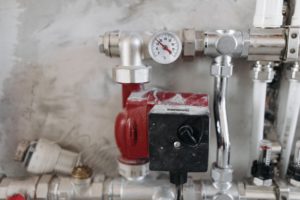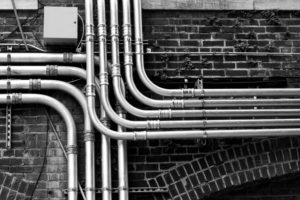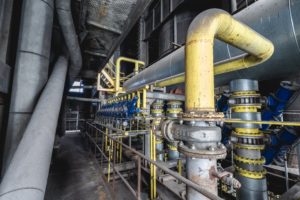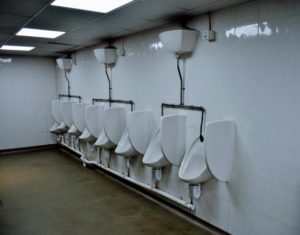Every restaurant owner knows that a smooth-running establishment requires more than just delicious food and excellent service. Behind the scenes, the plumbing system plays a pivotal role in ensuring everything runs seamlessly. From the kitchen to the restrooms, plumbing issues can quickly escalate, causing disruptions that can affect the restaurant’s operations and reputation. In this article, we’ll delve into common restaurant plumbing problems, how a skilled plumber can address them, the essential supplies for prevention, and the regulations in:
- Philadelphia
- Delaware
- New Jersey
Common Restaurant Plumbing Problems
- Grease buildup: One of the most common issues in restaurant plumbing is grease buildup. Grease can solidify in the pipes, causing blockages. Regular cleaning and maintenance are essential to prevent this.
- Drain clogs: Food particles, especially in the kitchen, can lead to drain clogs. It’s crucial to have strainers in place and ensure staff are trained not to dispose of large food particles down the drain.
- Leaky faucets and pipes: These can lead to water wastage and increased bills. Regular inspections can help identify and fix any leaks promptly.
- Toilet issues: With many customers using the restrooms, toilets can get clogged or run continuously. It’s essential to check them regularly and have a professional plumber on call for emergencies.
- Water heater problems: Restaurants require hot water for various tasks. Any issues with the water heater can disrupt the restaurant’s operations

Essential Supplies For Restaurant Plumbing
- Grease traps: These are essential for preventing grease from entering the plumbing system.
- High-Quality materials: Investing in high-quality materials can prevent frequent breakdowns and leaks. For instance, using stainless steel pipes, known for their corrosion resistance and durability, can significantly reduce the chances of leaks. Brass fittings, another top-quality choice, are known for their longevity and resistance to high temperatures.
- Water softeners: Hard water, which contains high mineral content, can damage pipes and fixtures over time. It leads to scale buildup, which can reduce water flow and pressure. One popular water softener brand is Culligan, renowned for its efficiency in removing mineral deposits from water. By installing a water softener, restaurants can prolong the life of their plumbing systems and reduce maintenance costs.
- Strainers: These prevent food particles from going down the drain, reducing the chances of clogs.
Preventing Plumbing Disasters in Restaurants
Plumbing Disasters in Restaurants
- Regular maintenance: Schedule regular plumbing inspections and maintenance. This can help identify potential issues before they become significant problems.
- Staff training: Ensure that your staff knows the basics of plumbing care, like not disposing of grease or large food particles down the drain.
- Emergency protocols: Have a plan in place for plumbing emergencies. This includes having a professional plumber you can call and ensuring staff knows where the main water shut-off is.
- Invest in quality: Don’t skimp on quality when it comes to plumbing materials and appliances. It might seem like a saving now, but it can lead to more significant expenses in the long run.
Plumbing Regulations for Restaurants
New Jersey Plumbing Regulations for Restaurants
- Plumbing Fixtures: Plumbing fixtures should be provided in numbers as specified in the building occupancy table. Drinking water facilities for customers are not required in restaurants or other food service establishments if drinking water service is available. Kitchen sinks and bar sinks can be used for employee drinking water facilities. In food preparation areas, fixture requirements might be dictated by local Health Codes. Fixtures for customers and employees can be centrally located and serve multiple establishments, especially in malls and transportation terminals. If the design number of customers in food handling establishments exceeds 100, separate facilities for employees and customers are required. Source
- General Regulations:Drain and vent piping should not be located above food preparation, storage, display, or serving areas where possible. If they must be installed above such areas, the amount of piping and the number of pipe joints should be minimized. Drain and vent piping above such areas should be subjected to a standing water test. Piping subject to operation at temperatures that may cause condensation on the external surfaces of the pipe should be thermally insulated to prevent condensation. Source
- Plumbing System: All plumbing systems should be designed, constructed, installed, and maintained in accordance with the New Jersey Uniform Construction Code. Plumbing fixtures such as handwashing facilities, toilets, or urinals should be easily cleanable. Source
Delaware Plumbing Regulations for Restaurants
- Plumbing program mission: The mission of the Plumbing Permit and Inspection Program in Delaware is to enforce the Delaware Plumbing Code in line with basic plumbing principles and regulatory requirements. The program provides rules and regulations for the construction of plumbing facilities where mandated, including restaurants.

- Food establishments: All food establishments in Delaware, including restaurants, must follow the plumbing requirements set forth by the Division of Public Health and submit a plan review for approval. The program ensures the construction of plumbing facilities adheres to the state’s plumbing code and regulatory requirements.
- Inspections: Licensed plumbers and DIY homeowners must have an approved permit before starting work and to receive an inspection. All plumbing installations must be ready when called in with provisions for the plumbing inspector to access the property. Plumbing must be visible to pass inspection, and properties cannot obtain a certificate of occupancy without passing the plumbing inspection.
- Fees: The Division of Public Health charges a $100 fee for plumbing permits. All permit fees are payable by check or money order only. The fees are used to provide program staff and infrastructure to protect public health.
- Regulations: The Delaware Public Health Plumbing Permit and Inspection Program utilizes the 2021 International Plumbing Code as Delaware’s plumbing code along with Delaware specific amendments.
Pennsylvania plumbing regulations for restaurants
Water source and quality
- Drinking water should be obtained from an approved source, either a public water system or a non-public water system that adheres to the law.
- Non-drinking water can only be used for non-culinary purposes like air conditioning, non-food equipment cooling, and fire protection.
- Water from a non-public water system should be sampled and tested at least annually.
- The water source and system should be of sufficient capacity to meet the peak water demands of the food establishment.
Plumbing System
- The plumbing system and hoses conveying water should be constructed and repaired with approved materials.
- A plumbing system should be designed, constructed, and installed according to the law.
- Backflow or backsiphonage prevention devices should meet the American Society of Sanitary Engineering (A.S.S.E.) standards.
Handwashing Sinks
- A handwashing sink should be equipped to provide water at a temperature of at least 29.4°C (85°F) through a mixing valve or combination faucet.
- An air gap between the water supply inlet and the flood level rim of the plumbing fixture should be at least twice the diameter of the water supply inlet.
- Handwashing sinks should be located for convenient use by employees in food preparation, food dispensing, and warewashing areas.
Service Sink
- At least one service sink or curbed cleaning facility with a floor drain should be provided for cleaning mops or similar wet floor cleaning tools and for the disposal of mop water and similar liquid waste.
Backflow Prevention
- A plumbing system should prevent backflow of a solid, liquid, or gas contaminant into the water supply system at each point of use in the food establishment.
- Backflow prevention devices should be installed to preclude backflow and should either provide an air gap or be an approved backflow prevention device.
Toilets and Urinals
- At least one toilet should be provided, and the number of toilets should not be fewer than what the law requires.
These regulations ensure that restaurants maintain a high standard of hygiene and safety, especially concerning water and waste management. Adhering to these guidelines is crucial to prevent any health hazards and ensure the well-being of both the staff and the customers.
For more detailed information or specific sections, you can refer to the FDA Food Code 2022 provided by the Pennsylvania Department of Agriculture.
It’s important to note that these are just summaries of the regulations, and there might be more detailed requirements and exceptions. If you’re planning to open or renovate a restaurant in these states, it would be advisable to consult with a local expert or authority to ensure full compliance with all regulations.
Conclusion
Restaurant plumbing can be a daunting task, especially when considering the myriad of regulations and standards that establishments must adhere to. From ensuring the quality of water sources to implementing proper backflow prevention, restaurants in Pennsylvania, New Jersey, and Delaware have a responsibility to uphold the highest standards of hygiene and safety. High-quality materials and water softeners play a pivotal role in preventing breakdowns, leaks, and the detrimental effects of hard water on plumbing systems.
But, with challenges come solutions. For restaurant owners and managers, partnering with a trusted plumbing service can make all the difference. At Action Plumbing, we pride ourselves on our deep industry knowledge, commitment to quality, and our ability to navigate and comply with regional regulations. Whether you’re facing a plumbing emergency or seeking preventive maintenance, our team is equipped to ensure your restaurant’s plumbing system runs smoothly, keeping your operations efficient and your customers satisfied.